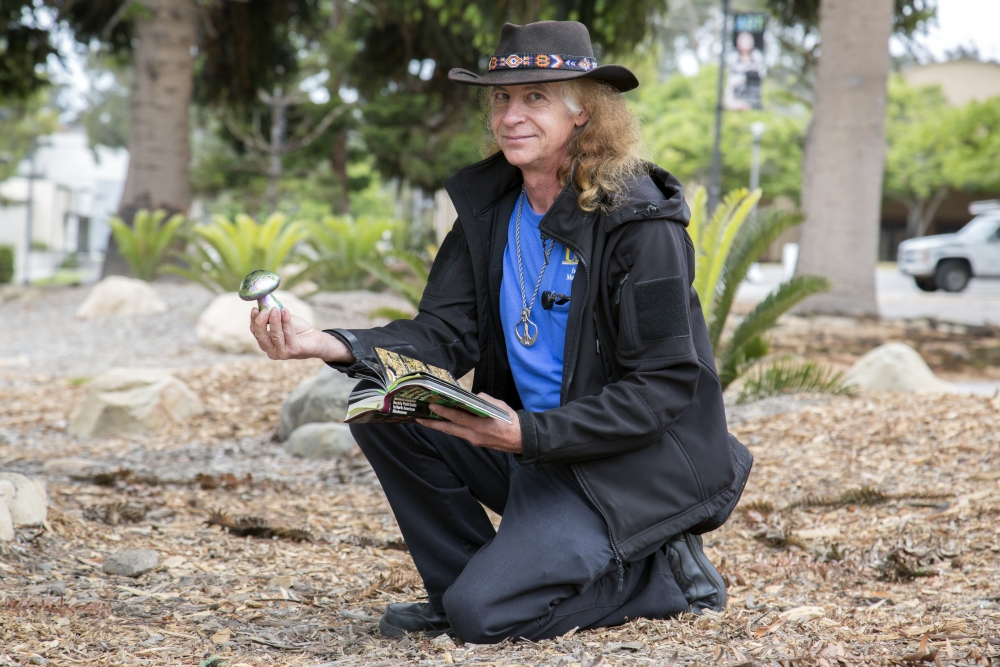
A Really Fungi
It’s 8 a.m. on a weekday and Richard O’Steen is in his usual spot, doing his usual thing. Just inside the east entrance of the UC Santa Barbara Library, hands full of mushrooms, he is engrossed in an online database.
A custodian in UCSB’s Engineering Sciences building, O’Steen has worked for the university for 33 years. He’s also a self-taught, deeply passionate expert on mushrooms and all things fungal, thanks largely to his regular lunch-break visits to the library (his shift runs from 2–10:30 a.m.), where he brings new findings for identification.
“I’ve been going ever since I became employed because it’s such a vast and great resource,” O’Steen said. “We have one of the best libraries around, with some of the nicest people.”
There, O’Steen grows his mushroom knowledge from a variety of sources, including databases run by both experts in mycology (the study of fungi) and enthusiastic amateurs. He cites the National Audubon Society Field Guide to North American Mushrooms as a major resource.
O’Steen first became interested in mushrooms in 1993, when he was bicycling home from work. “I saw this clump of mushrooms on the side of the road — a magnificent clump, with eight or nine caps of varying sizes,” he recalled. “It was a common species and it was edible. I cooked it up and ate it that night, and it was great.” A chat with O’Steen reveals fascinating mushroom facts, in quick succession: that chicken mushrooms, a local variety, exist in a symbiotic relationship with the eucalyptus trees on campus. That leafcutter ants actively farm fungus for their own use. That mushrooms break down the cellulose in dead wood, helping it become part of the soil again.
“I like all mushrooms simply because of their variety,” he said. “They lead me to new places a lot of times, and they have many different purposes.”
While he’s fascinated by the diversity of the mushroom kingdom, with specimens that range from the microscopic to “the size of a dinner plate,” O’Steen’s favorite species is still the first mushroom he ever found: the shaggy mane, a local inky cap variety that has the consistency of cooked shrimp and turns into black goo after it releases its spores.
In addition to his mushroom-hunting in the wilderness, O’Steen also does a fair amount of exploring on campus, where about a dozen edible species of mushrooms grow. “Half the time I forget a bag, so I’ll just carry five or six mushrooms in my hand,” he quipped. (Warning: not all the mushrooms that grow on campus are edible.)
“I was so impressed by him,” said Jane Faulkner, a reference librarian at UCSB who first met O’Steen when he asked a mushroom-related question. While most of the people who reach out to Faulkner are students and faculty, she stressed that the UCSB Library’s resources are available to everyone, including staff and members of the larger community. “As he was talking,” she said of O’Steen, “it occurred to me that this was exactly the sort of thing we should be championing: he’s a member of our community, but not a traditional researcher, and he’s using the resources of the library.”
And it’s not just mushrooms: O’Steen’s interests also include art, astronomy and engineering, making the university a perfect place for him to work. “It gives me the opportunity to grow and continue to learn,” he said. “It doesn’t take a lot of brains to do my job, so I dedicate that part of my brain to learning new things.”
Even working in the Engineering Sciences building is a boon for O’Steen. He’s been known to collect the nature and science journals that academics throw out, keeping up on the latest discoveries, and often enjoys chatting with engineering professors he encounters in his work. “They know I’m into a lot of different things,” he said, “and they occasionally help.”
That “help” sometimes includes sharing interesting new information, but it might also mean donating leftover high-tech materials — like a box of silicon wafers — to yet another of O’Steen’s hobbies: creating costumes for Santa Barbara’s annual Summer Solstice Festival.
Still, mushrooms seem to have stolen O’Steen’s heart. “They really are a part of the great cycle,” he said. “If it weren’t for funguses, we’d be hip-deep in woods.” O’Steen characterized mushrooms and other funguses as an essential but often unappreciated part of our natural ecosystem: they clean the soil and help trees to produce the oxygen that we breathe.
But despite their usefulness, for O’Steen, mushrooms and other fungi are their own reward. “They open your eyes,” he said. “You learn to look at things a little closer, you take more time to search out the mysteries, and you may find a surprise or two along the way.”



